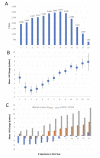Visual acuity outcomes and anti-VEGF therapy intensity in diabetic macular oedema: a real-world analysis of 28 658 patient eyes
- PMID: 32265201
- PMCID: PMC7848066
- DOI: 10.1136/bjophthalmol-2020-315933
Visual acuity outcomes and anti-VEGF therapy intensity in diabetic macular oedema: a real-world analysis of 28 658 patient eyes
Abstract
Background/aim: To assess visual acuity (VA) outcomes and antivascular endothelial growth factor (anti-VEGF) treatment intensity in diabetic macular oedema (DMO).
Methods: Retrospective analysis was performed in treatment-naïve patients with DMO from 2013 to 2018 using a database of aggregated de-identified electronic medical records (Vestrum Health).
Results: At 1 year, 28 658 patient eyes underwent a mean of 6.4 anti-VEGF injections, gaining a mean of +4.2 letters (95% confidence interval for mean gain: +4.0 to +4.5 letters, p<0.001). When stratified by anti-VEGF medication and by years 2013-2018, no clinically meaningful differences in injection frequency or 1-year VA change resulted. At 1 year, 50% of eyes received ≤6 injections, while <20% received 10-13 injections, representing monthly treatment. Mean letters gained at 1 year generally showed a linear relationship with mean number of anti-VEGF injections, beyond two injections. Eyes with good baseline VA (≥20/40) generally were at risk of VA loss at 1 year; those with moderately severe baseline impairment (20/70 to 20/200) who received ≥10 injections improved by a mean of +10.3 letters.
Conclusion: In clinical practice, patients with DMO undergo fewer anti-VEGF injections and exhibit worse visual gains compared with patients in randomised clinical trials. Visual outcomes correlate with treatment intensity at 1 year, with ceiling effects related to baseline VA.
Keywords: macula; retina; treatment medical.
© Author(s) (or their employer(s)) 2021. Re-use permitted under CC BY-NC. No commercial re-use. See rights and permissions. Published by BMJ.
Conflict of interest statement
Competing interests: JFP and DFW are co-founders of Vestrum Health.
Figures

References
-
- Stone T. Preferences and trends membership survey. 2018 Chicago, IL: American Society of Retina Specialists, 2018.
MeSH terms
Substances
LinkOut - more resources
Full Text Sources
Medical
